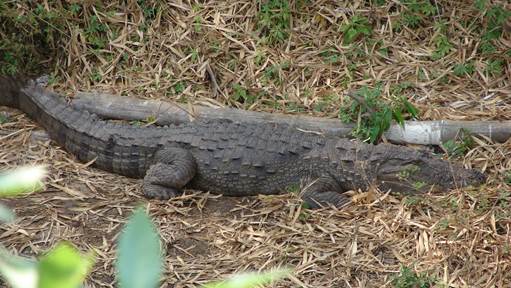|
River ecosystems of Uttara Kannada: Threats
Dams: Large to small sized dams used for hydroelectricity production and small sized local check dams for intense agriculture purposes. Both large and small check dam affects the riverine biodiversity and water quality.
Figure 29: Site showing check dam and loss of riparian vegetation. Site: Beegar, Yellapura Taluka.
Loss of riparian vegetation: Removal of riparian vegetation is observed in all river basins (figure 29). In particular streams flows next to the agriculture lands shows significant removal of riparian vegetations.
Water pollution due to domestic sewage: Bedthi River Basin, in particular upper reaches of Bedthi shows high level of water quality degradation due to the domestic sewage disposal in the main streams (Figure 30). Certain portion of the domestic sewage of Hubli town is disposed into upper Bedthi River (Figure 31). Sewage contaminants flows in to Bedthi River and later gets diluted by the water from tributary like Hasehall, which drains more water even during the summer months. Some of the sites, which are severely affected by the water pollution in Bedthi River basin are Sangadevarakoppa, Kalghatghi and Manchikeri (Yellapura).
Figure 30: Site showing sewage flowing in tributary of Bedthi.
Figure 31: Site showing sewage flowing in tributary of Bedthi
Industrial Pollution: Kali River Basin is under the influence of industrialization in Uttara Kannada, in particular Dandeli region with polluting industries. The West Coast Paper Mills Ltd situated in the bank of River Kali pollutes the water and surrounding riparian environment by letting partially treated or untreated effluents into the river. Kervada village, next to Dandeli witness severe water and air pollution due to the effluent of paper mill. Paper mill waste increases total dissolved and suspended solids, turbidity and ionic content. In addition to the effluents the river also receives sewage. Organic waste let in to the river decreases the dissolved oxygen, which eventually causes threat to aquatic biodiversity. Site where confluence of sewage is also witnessed soaring population of Mugger crocodiles (Figure 32) resulting in the higher instances of human wildlife conflicts.
 Figure 32: Mugger crocodile (Crocodylus palustris) in Kervada, Paper Mill effluent confluence point in Kali River Basin.
Sand Mining: Sand mining is one of the common problems observed in lower reaches of all the river basins (Figure 33). Sand mining is predominant in brackish water region of Kali and Sharavathi River Basins, where mechanized sand mining is in practice for a while. Sand mining cause severe threat to the benthic organisms. Most of the marine and esturine benthic organisms breed in brackish regions faces severe threat due to the mechanized sand mining. Mangrove regions in Kali estuary is also threatened by sand mining due to loss or alteration of habitat.
Figure 33 Mechanized sand mining in Kali River Basin
|
Dr. T.V. Ramachandra
Centre for Sustainable Technologies, Centre for infrastructure, Sustainable Transportation and Urban Planning (CiSTUP), Energy & Wetlands Research Group, Centre for Ecological Sciences, Indian Institute of Science, Bangalore – 560 012, INDIA.
E-mail : cestvr@ces.iisc.ac.in
Tel: 91-080-22933099/23600985,
Fax: 91-080-23601428/23600085
Web: http://ces.iisc.ac.in/energy
Subash Chandran M.DEnergy & Wetlands Research Group, Centre for Ecological Sciences, Indian Institute of Science, Bangalore – 560 012, INDIA.
E-mail: mds@ces.iisc.ac.in
Joshi N.V.Energy & Wetlands Research Group, Centre for Ecological Sciences, Indian Institute of Science, Bangalore – 560 012, INDIA.
E-mail: nvjoshi@ces.iisc.ac.in
Karthick B.
Energy & Wetlands Research Group, Centre for Ecological Sciences, Indian Institute of Science, Bangalore – 560 012, INDIA.
Sameer Ali
Energy & Wetlands Research Group, Centre for Ecological Sciences, Indian Institute of Science, Bangalore – 560 012, INDIA.
Vishnu D. Mukri
Energy & Wetlands Research Group, Centre for Ecological Sciences, Indian Institute of Science, Bangalore – 560 012, INDIA.
Citation:Ramachandra T.V., Subash Chandran M.D., Joshi N.V., Karthick B., Sameer Ali, Vishnu D. Mukri, 2012. Ecohydrology of Lotic Ecosystems of Uttara Kannada, Central Western Ghats , ENVIS Technical Report 40, Energy & Wetlands Research Group, CES, IISc, Bangalore, India.
| Contact Address : |
| |
Dr. T.V. Ramachandra
Energy & Wetlands Research Group,
Centre for Ecological Sciences, TE 15, New Biology Building, Third Floor, E Wing, [Near D Gate], Indian Institute of Science, Bangalore – 560 012, INDIA.
Tel : 91-80-22933099 / 22933503-extn 107
Fax : 91-80-23601428 / 23600085 / 23600683 [CES-TVR]
E-mail : cestvr@ces.iisc.ac.in, energy@ces.iisc.ac.in,
Web : http://wgbis.ces.iisc.ac.in/energy |
|